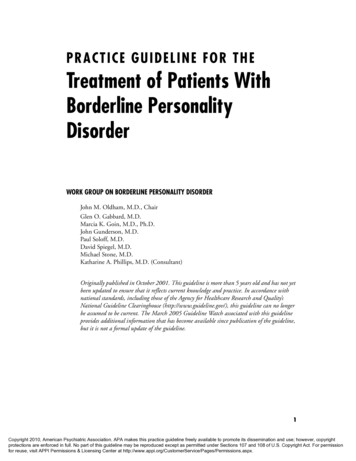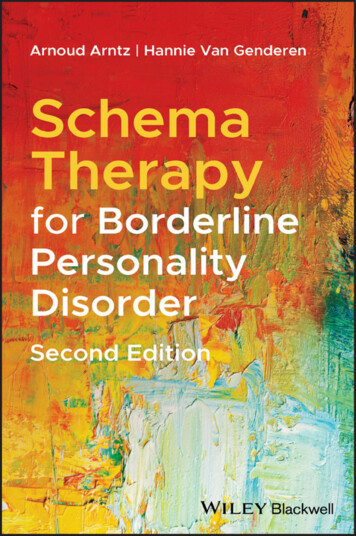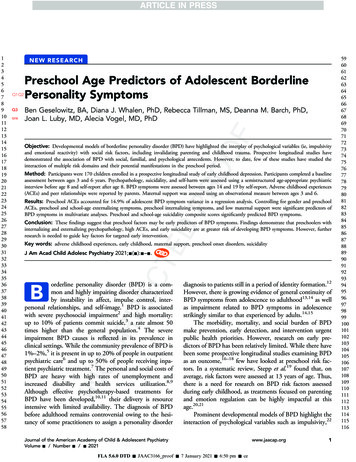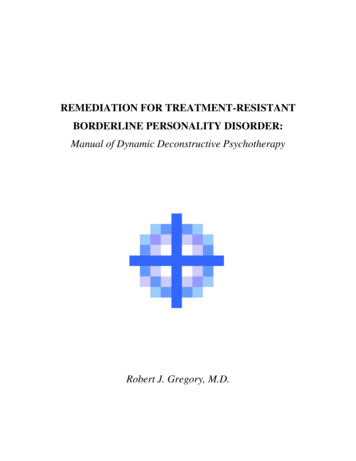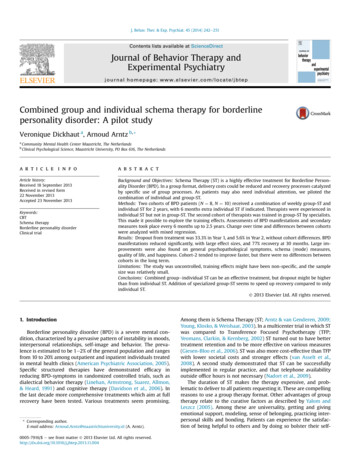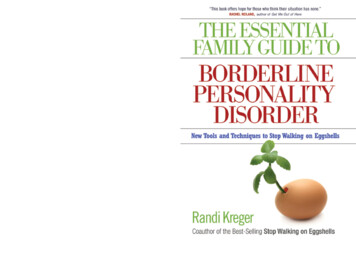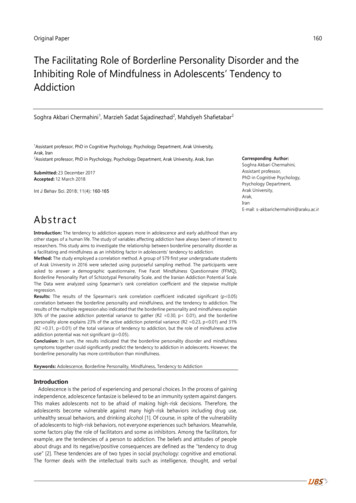
Transcription
Original Paper160The Facilitating Role of Borderline Personality Disorder and theInhibiting Role of Mindfulness in Adolescents’ Tendency toAddictionSoghra Akbari Chermahini 1, Marzieh Sadat Sajadinezhad2, Mahdiyeh Shafietabar 21Assistant professor, PhD in Cognitive Psychology, Psychology Department, Arak University,Arak, Iran2Assistant professor, PhD in Psychology, Psychology Department, Arak University, Arak, IranSubmitted: 23 December 2017Accepted: 12 March 2018Int J Behav Sci. 2018; 11(4): 160-165Corresponding Author:Soghra Akbari Chermahini,Assistant professor,PhD in Cognitive Psychology,Psychology Department,Arak University,Arak,IranE-mail: s-akbarichermahini@araku.ac.irAb s tractIntroduction: The tendency to addiction appears more in adolescence and early adulthood than anyother stages of a human life. The study of variables affecting addiction have always been of interest toresearchers. This study aims to investigate the relationship between borderline personality disorder asa facilitating and mindfulness as an inhibiting factor in adolescents’ tendency to addiction.Method: The study employed a correlation method. A group of 579 first year undergraduate studentsof Arak University in 2016 were selected using purposeful sampling method. The participants wereasked to answer a demographic questionnaire, Five Facet Mindfulness Questionnaire (FFMQ),Borderline Personality Part of Schizotypal Personality Scale, and the Iranian Addiction Potential Scale.The Data were analyzed using Spearman's rank correlation coefficient and the stepwise multipleregression.Results: The results of the Spearman's rank correlation coefficient indicated significant (p 0.05)correlation between the borderline personality and mindfulness, and the tendency to addiction. Theresults of the multiple regression also indicated that the borderline personality and mindfulness explain30% of the passive addiction potential variance to gather (R2 0.30, p 0.01), and the borderlinepersonality alone explains 23% of the active addiction potential variance (R2 0.23, p 0.01) and 31%(R2 0.31, p 0.01) of the total variance of tendency to addiction, but the role of mindfulness activeaddiction potential was not significant (p 0.05).Conclusion: In sum, the results indicated that the borderline personality disorder and mindfulnesssymptoms together could significantly predict the tendency to addiction in adolescents. However, theborderline personality has more contribution than mindfulness.Keywords: Adolescence, Borderline Personality, Mindfulness, Tendency to AddictionIntroductionAdolescence is the period of experiencing and personal choices. In the process of gainingindependence, adolescence fantasize is believed to be an immunity system against dangers.This makes adolescents not to be afraid of making high-risk decisions. Therefore, theadolescents become vulnerable against many high-risk behaviors including drug use,unhealthy sexual behaviors, and drinking alcohol [1]. Of course, in spite of the vulnerabilityof adolescents to high-risk behaviors, not everyone experiences such behaviors. Meanwhile,some factors play the role of facilitators and some as inhibitors. Among the facilitators, forexample, are the tendencies of a person to addiction. The beliefs and attitudes of peopleabout drugs and its negative/positive consequences are defined as the "tendency to druguse" [2]. These tendencies are of two types in social psychology: cognitive and emotional.The former deals with the intellectual traits such as intelligence, thought, and verbalIJBS
Akbari Chermahini et al.comprehension, and the latter with the personality traitssuch as attitudes, preferences, and needs [1]. As far asaddiction is concerned, the Tendency Theory states thatsome people are susceptible to addiction, that is, if theyare exposed to drugs, they become addicted, otherwise,they would not [3, 4].There are three categories of theories about the causesof addiction. The first group believes that as drugs areeasily available, people turn to it. The second categorybelieves that social crises and disorders are the cause oftendency to addiction. Finally, the third category focuseson the psychological potentials [5]. However, someindividuals with particular personality traits are moresusceptible to addiction than others. Studies haveidentified various psychological features, including theuse of emotionally avoidant coping strategies [6], pooremotional self-regulation [7], poor social skills [8], poorfunctioning of the family [9] and impulsivity andaggression [10]. These features, altogether, can cause apersonality disorder called the borderline personalitydisorder.The borderline personality disorder is a disturbance inthe B-cluster of the personality disorders and is the mostcommon personality disorder in psychiatrics. The mainfeatures of this disorder are an overwhelming pattern ofinstability in interpersonal relationships, self-depiction,emotions and apparent impulsivity, confusion of identity,emotional instability, chronic feeling of absurdity, fatigue,and self-harm. Impulsivity is the tendency and potentialto express quick and unpredictable responses to internalor external stimuli, regardless of their negativeconsequences [11]. Impulsive behavior, in many cases,leads to high-risk behaviors such as gambling, spendingmoney with no regard, overeating, substance abuse,sexual behaviors or high-risk driving [12]. Studies suggestthat the borderline personality disorder has about 67%correlation with substance abuse [11, 10, 13].The demand for drug is one of the apparent features ofthe borderline personality disorder [14]. The results ofJazayeri, et al.'s study [15] on addicted men indicated thatthe traits related to the borderline personality disorderamong addicts were significantly more prevalent than thecontrol group. The study also showed that the mainaspect of the individuals’ personality disorder depends ontheir personality traits before being addicted.Besides the facilitators, some factors also act asinhibitors against addiction. Some of them are mentalhealth, negative attitude towards drug use [17], socialsupport and coping strategies [18], tolerance [6], andmindfulness. However, mindfulness, among these, hasbeen studied less. According to Baer (2003), mindfulnessis “the nonjudgmental observation of the ongoing streamof internal and external stimuli as they arise” (p. 125).Mindfulness is a skill that allows individuals to perceiveincidents as being less depressing than what they reallyare in the actual situation. Mindfulness plays an importantrole in inhibition against addiction by reinforcing factorssuch as effective coping strategies against emotionalturmoil and momentum addiction [20], effective copingstrategies against temptation of visual clues [21], and the161acceptance of thoughts instead of suppressing them [22].Accordingly, the results of several studies [23, 19, 24, 25,26, 27] suggest that using interventions such as thetraining of mindfulness skill can be effective in reducingthe symptoms of addiction. Therefore, it seems that therole of mindfulness can be considered as an inhibitor inthe tendency to addiction. As the tendency to addictionappears more common in adolescence and earlyadulthood [16], the study of traits affecting addiction havealways been of interest to researchers. Therefore, thisstudy aims to investigate the relationship between theborderline personality disorder as a facilitator andmindfulness as an inhibitor in the adolescents’ tendencyto addiction.MethodsThis study used a correlational and cross-sectionalmethod. Among the undergraduate university students ofArak University (first year university students at the age of20), 579 participants (350 women and 229 men) with amean age of 19.2 (SD 0.5) were selected using thepurposeful sampling method. Since the aim of the studywas to examine the relationship among variables inadolescents, the participants’ age was an importantvariable. Therefore, the participants were asked tocomplete a set of questionnaires. After a brief overview ofthe topic of the study, the participants completed thequestionnaires in groups. The approximate time tocomplete the questionnaires was 30 minutes, and theparticipants were free to end their contribution at anystage of the research.An oral informed consent was obtained from allparticipants included in the study. The protocol wasapproved by the local ethical committee (Arak UniversityIran).The research questionnaires which were administered tothe participants were as follows:Iranian Addiction Potential Scale: The AddictionPotential Scale was designed by Weed Butcher (1992).There have been many attempts to determine its validityin Iran. The questionnaire used in this study, is an Iranianversion of the Addiction Potential Scale which is designedby Zargar (2006) regarding the psychological and socialconditions of the Iranian society. It consists of two factors.It has 36 items as well as 5 lie detector items. In the firstfactor (the active addiction potential), the highestproportions are attributed to antisocial behavior, desire touse drugs, positive attitude to drugs, and excitement. Inthe second factor (the passive addiction potential), thehighest proportions are attributed to the lack of selfexpression and depression. The scoring procedure of eachitem was based on a continuum from zero (totallydisagree) to 3 (totally agree). In order to assess the validityof this scale, two methods were employed. As far as thecriterion validity is concerned, the addiction potentialquestionnaire well-differentiated both the addicted andnon-addicted groups. The validity of the scale structurewas assessed by correlating it with the 25-item Scale ofClinical Symptom Scale (SCL-25) 0.45, which wassignificant at a level less than 0.001. The reliability of theInt J Behav Sci Vol.11, No.4, Winter 2018
The Facilitating Role of Borderline Personality Disorder and the Inhibiting Role of Mindfulnessscale was assessed using Cronbach's alpha 0.9, which isoptimal (28). The Cronbach's alpha value for the firstfactor (the active addiction potential) is 0.89, and for thesecond factor (the passive addiction potential) is 0.76 (29).According to the Cronbach’s alpha method in this study,the reliability of the total scale was 0.94, and it was 0.95and 0.81 for the active and passive factors isinstrument is a 39-item questionnaire using a self-reportassessment method developed by Baer, Smith, Hopkins,Krietemeyer, and Tony (2006). It is developed ires such as: The Kentucky Inventory ofMindfulness Scale (30), the Mindful Attention AwarenessScale (31), the Freiburg Mindfulness Inventory (32), theCognitive and Affective Mindfulness Scale-Revised (33),and the Southampton Mindfulness Questionnaire (34),based on the factor analytic approach. The analysis revealfive factors indicating different aspects of mindfulness.These factors are observation, description, acting withawareness, non-judgment of the inner experience, andnon-reactivity to the inner experience. The responseswere pre-coded from 1 to 5 based on a Likert’s five-pointscale. Based on the results, the consistency of the factorswas acceptable and the alpha coefficient ranged from 0.75to 0.91. The correlation between the factors wasmoderate, and in all cases, it was significant and rangedfrom 0.15 to 0.34 (Neuser, 2010). Moreover, in a study onthe validity and reliability of this questionnaire in Iran, thecorrelation coefficients of the test-retest of the abovementioned questionnaire in the Iranian version wasbetween 57.0 and 84.0. The alpha coefficients were alsoobtained at an acceptable level of 0.55 to 0.83 (35).Borderline Personality Scale: The borderlinepersonality scale is a part of the Schizotypal TraitQuestionnaire. This questionnaire was developed byClaridge and Broks (1984) at Oxford University and thenwas revised by Rawlings, Claridge and Freeman (2001).Mohammadzadeh and Rezaee [36], using the editedversion of this test according to the criteria of DSM-IV-TR,in addition to the 18 primary items, added another 6 itemsto cover the diagnostic criteria of the disorder. Thus, theborderline personality scale, used in this study, had 24items which requires a Yes/No response. This scalemeasures three traits of hopelessness, impulsivity, andstress-related dissociative and paranoid symptoms.Rawlings et al. (2001) reported an alpha of 80% for the12345borderline personality scale. The concurrent validity of theborderline personality scale with neuroticism andpsychoticism scales of Eysenck personality questionnairein its original culture was reported to be 0.64 and 0.44,respectively. The coefficient of the test-retest reliability ofthe total borderline personality scale in the Iranian societywas 0.84, and for the subscales of hopelessness,impulsivity, and stress-related dissociative and paranoidsymptoms were reported to be 0.53, 0.72 and 0.50,respectively. Also, the alpha coefficient of the total scalewas 0.77, and for the subscales of hopelessness,impulsivity, and stress-related dissociative and paranoidsymptoms were 0.64, 0.58 and 0.57, respectively [36].ResultsThe data analysis was performed using the scoresobtained from the completed questionnaires of all themembers of the groups participating in the study. In thefirst step, in addition to computing the mean and standarddeviation of the variables under investigation, thecorrelation between the variables was also calculated. Theresults are presented in Table 1.The results of the Pearson correlation coefficients inTable 1 indicate that there is a significant positivecorrelation between the borderline personality trait andtendency to addiction in the adolescents participating inthis study, as well as, the active and passive addictionpotential subscales. Moreover, the variable of mindfulnesshas a significant negative correlation with the passiveaddiction potential. However, there is no significantcorrelation between mindfulness and the active addictionpotential and the total score of tendency to addiction.The stepwise multiple regression analysis was employedin order to determine the relationship among variablesmore accurately and to also identify the contribution ofeach variable under investigation to explain the tendencyto addiction. In this analysis, the borderline personalitywas fed as the only predictor variable in the regressionequation. The results presented in Table 2 indicate that31% of the variance of tendency to addiction is explainedby the borderline personality variable. In fact, as thestudents’ borderline personality scores increase, theirtendency to addiction will increase too. Thus, the variableof mindfulness did not play a significant role in explainingthe tendency to addiction and therefore, it was notpresented in the regression analysis results.Table 1. Descriptive statistics (Mean and Standard Deviation) and Pearson correlation coefficients among variablesvariablesMSD1234active addiction potential subscales19.117.141passive addiction potential subscales15.956.760.47**Total score of tendency to addiction34.9321.270.96**0.7**borderline personality 9-0.06-0.1*-0.068-0.07* p 0.05 ; ** p 0.01Table 2. Results of multiple regressions of total score of addiction potential on borderline personality traitcriterion variableβstepPredictor variableFR2tTotal score of addiction potentialfirstborderline personality trait245.20.312.8215.66*** p 0.05 ; ** p 0.01Int J Behav Sci Vol.11, No.4, Winter 2018162
Akbari Chermahini et al.Table 3 shows the results of the stepwise regressionanalysis for multiple relationships among the predictivevariables with the active addiction potential subscale. Theborderline personality was considered as the onlypredictor variable in the regression equation. The resultspresented in Table 4 indicate that 23% of the variance ofthe active addiction potential is explained by theborderline personality variable. The variable ofmindfulness did not indicate a significant role inexplaining the tendency to addiction, and therefore, it wasnot available in the regression analysis results.Table 4 shows the results of the among the predictive variables with the passiveaddiction potential subscale. In the first step, theborderline personality was considered as the onlypredictor variable in the regression equation. Theresults presented in Table 4 indicate that 28 % ofthe variance of the passive addiction potential isexplained by the borderline personality ulness together can explain 30 % of thevariance of the passive addiction potential. In otherwords, 30 % of the variance in the ted to the borderline personality andmindfulness. The value of beta coefficient (β 0.826) indicate that as the score of the borderlinepersonality scale increases, the passive addictionpotential increases too. As far as mindfulness isconcerned, beta coefficient (β 0.084) is negativelysignificant. In other words, as the value l decreases among adolescents.Table3. Results of multiple regressions of active addiction potential subscales on borderline personality traitcriterion variableβstepPredictor variableFR2tactive addiction potential subscalesfirstborderline personality trait168.280.231.9512.97 *** p 0.05 ; ** p 0.01Table 4. Results of multiple regressions of passive addiction potential subscales on borderline personalitycriterion variablestepPredictor variableFR2Passive addiction potential subscalesfirstborderline personality trait217.320.28borderline personality traitsecond116.230.30mindfulness* p 0.05 ; ** p 0.01DiscussionSubstance abuse puts adolescents in grave risk ofacademic failure, low adaptability and progress, thus,endangering their job opportunities in future [6]. Studyingthe causes of addiction among adolescents is importantbecause it will be very helpful in its prevention and earlytreatment. The aim of this study was to investigate therelationship between the borderline personality variablesas facilitators and mindfulness as an inhibitor against thetendency to addiction among Arak University students.According to the results, it seems that the borderlinepersonality has a significant positive relationship withboth active and passive addiction potential. This meansthat as the borderline personality scores increase, bothactive and passive addiction potential will increase too.The findings of this study are consistent with the findingsof Jazayeri et al. [15] and Molavi et al. [13].The active addiction potential, in this study, meansantisocial behavior, the desire to use drug, positiveattitude to drugs, and the excitement that predisposes aperson to be addicted. One of the main symptoms of theborderline personality disorder is the intense anddisproportionate anger and the inability to control one'sbehavior in social situations, which is one of the featuresof the antisocial personality. Therefore, it seems that theborderline personality disorder provides the context forthe active addiction potential by strengthening theaggressive and antisocial behaviors. Also, the chronicfeeling of absurdity and fatigue in these patients usuallyleads to seeking excitement in order to relieve the feelingof boredom. Accordingly, seeking excitement in these163trait and individuals is high. This particular feature, besides beingthe cause of extraordinary impulsivity in these individuals,leads to an active addiction potential towards using drugsand alcohol [11].The passive addiction potential, in this study, meansself-expression and depression. One of the features ofidentity turmoil in individuals suffering from borderlinepersonality disorder is the sense of intense absurdity andmeaninglessness. Such feelings may be due to individuals’extreme investment on their own system of values andideals that can provide the basis for addiction. Severalresearchers have suggested the relationship of theborderline personality and drug abuse in their studies [10,13]. Alilu and Sharifi [11] also identified the relationshipbetween the borderline personality disorder andsubstance abuse to be between 14-54 percent. Studiesindicate that the individuals who suffer from theborderline personality disorder, more than any otherpsychiatric disorders except the antisocial personalitydisorder, meet the diagnostic criteria of a substance abusedisorder. About 57% of individuals suffering fromborderline personality disorder also have the diagnosticcriteria for substance abuse disorder [37]. According tothe results of the current study, the symptoms of theborderline personality disorder can, to some extent,predict the tendency to addiction and high-risk behaviorsamong adolescents.As far as mindfulness as an inhibitor is concerned, theresults of this study indicate that this variable cannot be astrong predictor of the active addiction potential. In fact,it failed to predict anti-social behavior, desire to use drug,Int J Behav Sci Vol.11, No.4, Winter 2018
The Facilitating Role of Borderline Personality Disorder and the Inhibiting Role of Mindfulnessthe positive attitude to drugs, and the excitement that hasan effective role in addiction. However, it can play asignificant role in predicting passive addiction potential,or what is known as the lack of self-expression anddepression. Based on the results, as the passive addictionpotential increases, mindfulness decreases. Many studiesconfirm these findings and show the role of mindfulnessin addiction.To explain the negative relationship between drug useand mindfulness, one reason could be reviewing the pastmistakes and the worries about the future. These thoughtsact against being mindful which forces individuals to befocused in the present time. Hence, it seems that thosewho have a higher level of mindfulness have less desire touse drugs as a temporary way of forgetting or getting ridof thoughts and worries. Also, recent studies have shownthat difficulty to accept of emotion could predictsubstance abuse [38] and both mindfulness andmindfulness-based meditation include neurologicalqualities that act against the negative emotions such asdepression [39,40], and thus, act as an inhibitor againstdrug use.The negative relationship between mindfulness anddrug use may also be related to the disturbance ofattention regarding thoughts and events, which leads toimpulsivity and weakness in decision making. In otherwords, the decrease of mindfulness and the increase of aperson's reliance on biased judgments can lead to themaladaptive and unwanted thoughts and actions such asdrug use. In contrast, having a non-judgmental awarenessof the present time allows more skillful response todiscomforting emotional states or behavioral impulses.As far as addictive behaviors are concerned, severalstudies [for example, 41] have evaluated the effectivenessof the mindfulness-based interventions in the treatmentof drug use problems and have suggested variouspossible mechanisms.ConclusionSince mindfulness means the ability to acceptnegative emotions in a non-judgmental way [42],and that there are features such as intenseimpulsivity, intense and disproportionate anger,and the instability in interpersonal relationships inthe borderline personality disorder, [11] it seemsunlikely that a person with such features canacceptitsnegativeemotionswithoutanyjudgment. Therefore, it can be concluded that therelationship between the borderline personalityand the weakness of mindfulness, which oftenoccur together, can predispose a person toaddiction.Like many other studies in the area of addictionand its underlying factors, this study also has somelimitations, including the limitations of measuringinstruments, which require more precise tools tomeasure the tendency to addiction in adolescence.It is suggested that further research should becarried out using more precise tools and considerInt J Behav Sci Vol.11, No.4, Winter 2018some more factors in tendency to addiction suchas family and experiences of individuals.Acknowledgments: The authors are thankful to theArak University for providing an opportunity to performthe tests, and to all the participants for their contributionto this 5.16.17.18.Salimi H , Gohari Sh , Kermanshahi F, Javdan M. On thePrediction of Addiction Potential Based on Family Process andContent Model in High School Students. Quarterly Journal ofResearch on Addiction. 2015; 9 (34): 53-66.[Persian]Adrom M, Nikmanesh Z. Prediction of Addiction Potential inYouth According to Personality Trait. Zahedan Journal ofResearch in Medical Sciences. 2012; 14 (2):101-104. [Persian]Gendreau P, Gendreau L P. The" addiction-prone" personality:A study of Canadian heroin addicts. Canadian Journal ofBehavioural Science/Revue canadienne des sciences ducomportement. 1970; 2(1), 18.Franke P, Neef D, Weiffenbach O, Gänsicke M, Hautzinger M,Maier W. [Psychiatric comorbidity in risk groups of opioidaddiction: a comparison between opioid dependent and nonopioid dependent prisoners (in jail due to the German narcoticslaw)]. Fortschritte der Neurologie-Psychiatrie. 2003; 71(1), 3744.Faridkiya S. The study of influence of family malfunctions onchildren addiction. Journal of management system. 2010; 2(1):179-202. [Persian]GhanbariTalab M, Fooladchang M. On the relationship ofresiliency and subjective vitality with addiction potential amongstudents. Research on Addiction Quarterly Journal of DrugAbuse. 2015; 9(34): 9-22. [Persian]Kuvaas N J, Dvorak RD, Pearson M R, Lamis DA, & SargentEM. Self-regulation and alcohol use involvement: A latent classanalysis. Addictive behaviors. 2014; 39(1), 146-152.Kakia L. The effectiveness of social skills training in reducingdrug-taking. Journal of Lorestan Medical Sciences. 2010; 12(3):3-36. [Persian]Brook JS, Brook DW, Arencibia-Mireles O, Richter L, &Whiteman M. Risk factors for adolescent marijuana use acrosscultures and across time. The Journal of genetic psychology.2001; 162(3), 357-374.Dostian Y, Bahmani B, Aazami Y, Godini Aa. The Relationshipbetween Aggression and Impulsiveness with Susceptibility forAddiction in Male Students. Rehabilitation. 2013; 14(2): 102109. [Persian]Alilu MM, Sharifi MA. Borderline personality disorder. 2012.Tehran. Arjmand publisher. [Persian]Kaplan HI, Sadock BJ. Comprehensive textbook of psychiatry.1989; Vols. 1 & 2. Williams & Wilkins Co.Molavi P, Sadeghi Movahhed F, Aboulhasanzadeh M, MashoofiM, Mohammadnia H, Dailami P, Arab R. A Survey ofPersonality Disorders among Individuals with Substance AbuseDisorder (Opiates) Referring to the Reference AddictionTreatment Center of Ardabil. Journal of Ardabil University ofMedical Sciences. 2009; 9(4): 325-333. [Persian]Millon T. Personality and psychopathology: Building a clinicalscience: Selected papers of Theodore Millon. 1996; John Wiley& Sons Incorporated.Jazayeri A, Hazhir F, Pourshahbaz A, Rezaee M. Relationshipbetween anti-social and borderline personality disorder andaddiction in kermanshahi men (18-35 years old). Hakim researchjournal. 2004; 7(1): 49-54. [Persian]Zeinali A, Wahdat R, Eisavi M. Pre-addiction susceptibilitybackgrounds in recovered drug users. Iranian Journal ofPsychiatry and Clinical Psychology. 2008; 14 (1):71-79.[Persian]Knyazev GG. Behavioural activation as predictor of substanceuse: mediating and moderating role of attitudes and socialrelationships. Drug and alcohol dependence. 2004; 75(3), 309321.Tucker JS, Ellickson PL, Orlando M, Klein DJ. Predictors ofattempted quitting and cessation among young adult smokers.Preventive medicine. 2005; 41(2), 554-561.164
Akbari Chermahini et al.19. Baer RA. Self-focused attention and mechanisms of change inmindfulness-based treatment. Cognitive Behaviour Therapy.2009; 38(S1), 15-20.20. Garland EL, Schwarz NR, Kelly A, Whitt A, Howard MO.Mindfulness-Oriented Recovery Enhancement for AlcoholDependence: Therapeutic Mechanisms and InterventionAcceptability. Journal of Social Work Practice in the Addictions.2012; 12(3): 242-263.21. Garland EL, Gaylord SA, Boettiger CA, Matthew O, HowardMO. Mindfulness Training Modifies Cognitive, Affective, andPhysiological Mechanisms Implicated in Alcohol. Journal ofPsychoactive Drugs. 2010; 42(2): 177-192.22. Bowen S, Witkiewitz K, Dillworth TM, Marlatt GA. The role ofthought suppression in the relationship between mindfulnessmeditation and alcohol use. Addictive Behaviors. 2007; 32(10):2324–2328.23. Leigh J, Bowen S, Marlatt GA. Spirituality, mindfulness andsubstance abuse. Addictive behaviors. 2005; 30(7):1335-41.24. Leigh J, Neighbors C. Enhancement motives mediate the positiveassociation between mind/body awareness and college studentdrinking. Journal of social and clinical psychology. 2009; 28(5),650.25. Fernandez AC, Wood MD, Stein LA R, & Rossi JS. Measuringmindfulness and examining its relationship with alcohol use andnegative consequences. Psychology of Addictive Behaviors.2010; 24(4), 608.26. Dakwar E, Mariani JP, Levin FR. Mindfulness impairments inindividuals seeking treatment for substance use disorders. TheAmerican journal of drug and alcohol abuse. 2011; 37(3), 165169.27. Shorey RC, Brasfield H, Anderson S, Stuart GL. Mindfulnessdeficits in a sample of substance abuse treatment seeking adults:A descriptive investigation. Journal of substance use. 2014;19(1-2), 194-198.28. Zargar Y. The development of Iranian addiction potential scale.The second Congress of Psychology. 2006. Tehran, Iran.[Persian]29. Zargar Y, Rahimi Pordanjani T, Ebrahimi AM, Noruzi Z. AStudy of simple and multiple relationships between morningnessand sleep quality among students with addiction potential inShahid Chamran University. Scientific Medical Jour
Conclusion: In sum, the results indicated that the borderline personality disorder and mindfulness symptoms together could significantly predict the tendency to addiction in adolescents. However, the borderline personality has more contribution than mindfulness. Keywords: Adolescence, Borderline Personality

